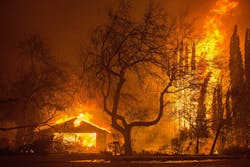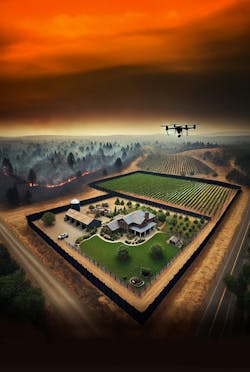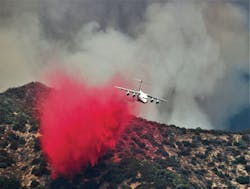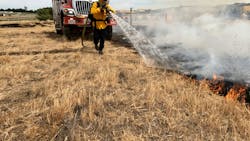Preparing for Wildfires: Embracing Community Partnerships and Technology to Save Lives
During my decades in the fire service, I have witnessed firsthand how high-wind events transform seemingly manageable fires into catastrophic disasters that devastate communities.
The wildland urban interface, where homes and businesses meet undeveloped wildlands,
and even open spaces that are within communities present unique challenges that require innovative approaches to fire prevention and response.
First line of defense
No fire department, regardless of size or resources, can protect communities effectively without active resident participation. Community involvement must become the cornerstone of wildfire defense strategy. We learned that in my own agency in 2016 as we faced the looming threat of wildfire and drought conditions. In doing so, our agency was recognized and awarded the 2018 Wildfire Mitigation Award by the International Association of Fire Chiefs. Our strategy and success were multifold.
Successful community partnerships include:
- Neighborhood fuels-reduction programs by which residents operate as partners in fuels reduction on their property and adjoining areas or common space.
- Communitywide vegetation management programs to create defensible space in wildfire-prone areas, such as roadways, vacant lots and hillsides.
- Regular community education events on evacuation protocols and home hardening techniques.
- Collaborative development of specific community evacuation plans.
When residents understand their role in fire prevention and preparedness, they become valuable partners in protecting lives and property.
Knowledge is power
Pre-incident planning represents a proactive shift from reactive firefighting to strategic preparation. This approach involves:
- Detailed mapping of high-risk areas and vulnerable populations, particularly in areas of rural settings, to include fire modeling in known high-risk areas based on historic events.
- Identification of access challenges, water supply limitations and nondefensible buildings.
- Development of tactical response plans for specific high-risk locations (i.e., pre-positioning of resources).
- Regular multi-agency training exercises that are based on realistic scenarios. These should be held every six months in
fire-prone regions.
All of these efforts ensure that when fires occur, responders have the information and protocols that are needed so that they can act decisively and effectively.
Leveraging AI and predictive technology
Perhaps the most exciting advancement in our field is the integration of artificial intelligence (AI) and predictive modeling into fire prevention and response. These technologies are revolutionizing how departments and their members prepare for high-wind events.
When I worked in San Diego County, I was fortunate to operate side by side with some of the best at developing and implementing the use of predictive modeling and AI into the world of wildfire pre-incident planning and response.
AI-powered fire prediction systems now analyze vast datasets, including weather patterns, fuel conditions, topography and historical fire behavior, to forecast where and when fires are most likely to occur. This allows for strategic pre-positioning of resources before fires start.
Fire modeling software can simulate how fires might spread under various wind conditions, which helps to identify communities that are at greatest risk during specific weather events. These models guide evacuation planning and resource-allocation decisions that previously relied heavily on experience and intuition.
Drone technology that has thermal imaging capabilities allows us to monitor hot spots and fire progression in real time, to provide incident commanders with critical information to make tactical decisions that protect both firefighters and communities.
Building resilient communities
Beyond response preparation, we must prioritize preventative measures that reduce fire risk:
- Strategic fuels-reduction projects in high-risk wildland areas and open space in urban communities.
- Strict enforcement of defensible space requirements around structures is a critical and yet difficult aspect.
- Updates to building codes that require fire-resistant construction in wildland interface areas. We must work with elected officials to help to pass legislation and codes that mandate this aspect of prevention.
- Improved power infrastructure management during high-wind events, such as public safety power shut-offs (PSPS).
These measures require significant investment but pale in comparison to the costs of major wildfire disasters.
Critical role of legislative stakeholders
The most comprehensive prevention strategies can’t succeed without proper funding and regulatory support. Legislative stakeholders at local, state and federal levels play a vital role in wildfire prevention and response. Their contributions include:
- Allocation of sufficient funding for roadway clearance and vegetation management in high-risk areas.
- Support for prescribed burning programs that reduce fuel loads in a controlled manner.
- Development of regulations that require and incentivize fire-resistant building practices.
- Creation of grant programs to help communities to implement fire prevention measures.
- Establishment of policies that facilitate interagency coordination during high-risk events.
Legislators who understand the economics of fire prevention—that every dollar that’s spent on prevention can save multiple dollars in suppression and recovery costs—are invaluable partners in creating fire-resilient communities.
Public-private partnerships
The collaboration between fire agencies and private sector partners, particularly utility companies, has emerged as a powerful strategy for fire prevention. San Diego Gas & Electric (SDGE) provides an exemplary model of such partnerships. Following the devastating 2007 wildfires, SDGE implemented comprehensive measures to reduce fire risks that were associated with its infrastructure:
- Sophisticated weather-monitoring network that provides real-time data on wind speeds, humidity and temperature at critical locations.
- PSPS during extreme wind events to prevent power line-related ignitions.
- Dedicated fire prevention crews that accompany power line work teams, to provide immediate suppression capability if work activities create ignition risks.
- Hardening of power infrastructure through undergrounding lines, replacing wooden poles with steel and installing covered conductors in high-risk areas.
- Funding community education and vegetation-management plans in partnership with local fire departments.
This collaboration significantly reduced utility-related fire ignitions during high-wind events. The collective work also created a template for partnerships that other regions can adapt and implement.
Moving forward together
As climate patterns continue to change and development expands into wildland areas, our approach to fire protection must evolve. The integration of community involvement, thorough pre-incident planning, advanced technology, comprehensive preventative measures, legislative support and public-private partnerships creates a holistic strategy that can save lives and property.
The destructive fires that scarred our landscapes and communities should serve not only as painful memories but as catalysts for innovation and improvement. By embracing these approaches and committing to ongoing advancement, we can build communities that are prepared, resilient and better protected from the threat of wind-driven wildfires.
The fire service alone can’t accomplish this mission. It requires the collaboration of government agencies, private sector partners, community organizations, individual residents and committed legislators. Together, we can face wildland fires in the urban space with confidence, knowing that we did everything that’s possible to prepare for whatever challenges might come.
Product Spotlight
Wildfire Defense System
WFS Selfguarding from INCA is a wildfire defense system that stops fires before they reach critical areas. It combines fire-blocking WFS net, AI-driven sensors and a wildfire management system. The system detects risks, coordinates responses and monitors threats in real time. It isn’t just fire suppression; it’s wildfire prevention redefined, for a smarter, more resilient future.
Wildland Firefighting Solutions
Perimeter Solutions’ PHOS-CHEK fire retardants, foams and gels are effective solutions for wildland fires. Trusted since 1963, the company’s innovative products include ultra-high-visibility aerial fire retardants, ground-based retardants, top-tier Class A foams and unique fire-suppressant gel, as well as a wide range of equipment and services.
Smoothbore Nozzle
HEN Nozzle’s 20 gpm or 45 gpm @ 100 psi Blade smoothbore nozzle makes precious water count. The nozzle produces large droplets in a triangular shape with a concentrated edge or a tight solid stream. Both deliver a 120-fps exit velocity, to combat wind and evaporation and to provide long reach, all the while producing superior wet lines that thoroughly coat fuels (green, black and burning) that are extremely resistant to slop over, chucking or burn-through.
Learning from the Past
History has taught us painful lessons about wind-driven fires in Southern California. I recall taking a staff ride through the area that was affected by the 1980 Panorama Fire. The chief who led the staff ride walked us down a street, indicating which houses burned and the few that survived. Little did I know that eight years later during the 2003 Grand Prix Fire I would be assigned to that same street, watching the same houses burn and, almost to a house, seeing the same houses survive.
The 1961 Bel Air Fire destroyed 484 houses in Los Angeles and forever changed our understanding of wildland urban interface fires. As a young firefighter, I was fortunate to learn from one of the first-responding chiefs to that fire. He spent time explaining to me what went well and what didn’t.
Over the years, we learned some lessons from some fires, while from others we didn’t. During the siege of 2007, the Harris and Witch Creek Fires in San Diego County collectively burned more than 288,000 acres and destroyed more than 1,600 homes. As a chief officer, I was called in from home within the first few hours of the fires, only to drive through walls of flames as fire burned homes and businesses on both sides of the freeway and the entire center medium burned for miles upon miles. The devastating effects on urban cities became a reality as the fires burned across the entire county.
These disasters share common elements: extreme wind conditions, rapid fire spread and communities caught unprepared. However, they also prompted vital improvements in how we approach fire prevention and response
About the Author
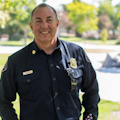
Edward Hadfield
Edward Hadfield recently served as the fire chief and fire coordinator for the Weatherford College Fire Academy in Weatherford, TX. He previously served as the fire chief for the Rincon Fire Department in San Diego. Hadfield is a 38-year veteran of the fire service in southern California. He established regional fire command programs, mentoring models, and health and safety programs. As a researcher, Hadfield collaborated with Underwriters Laboratories and NIST on studies that advanced firefighting tactics, safety protocols and building code developments.
